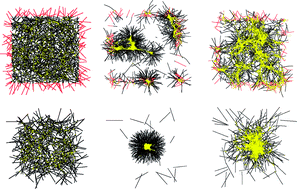Aster formation and rupture transition in semi-flexible fiber networks with mobile cross-linkers
Abstract
Fibrous active network structures whose properties are regulated by motor

* Corresponding authors
a
Helsinki University of Technology, LCE, P.O. Box 9203, Finland
E-mail:
astrom@csc.fi
b
Department of Physics, Indian Institute of Technology Madras, Chennai 600036, India
E-mail:
sunil@physics.iitm.ac.in
c
Department of Applied Mathematics, The University of Western Ontario, 1151 Richmond Street North, London, ON, Canada
E-mail:
mkarttu@uwo.ca
Fibrous active network structures whose properties are regulated by motor

 Please wait while we load your content...
Something went wrong. Try again?
Please wait while we load your content...
Something went wrong. Try again?
J. A. Åström, P. B. S. Kumar and M. Karttunen, Soft Matter, 2009, 5, 2869 DOI: 10.1039/B815892D
To request permission to reproduce material from this article, please go to the Copyright Clearance Center request page.
If you are an author contributing to an RSC publication, you do not need to request permission provided correct acknowledgement is given.
If you are the author of this article, you do not need to request permission to reproduce figures and diagrams provided correct acknowledgement is given. If you want to reproduce the whole article in a third-party publication (excluding your thesis/dissertation for which permission is not required) please go to the Copyright Clearance Center request page.
Read more about how to correctly acknowledge RSC content.
 Fetching data from CrossRef.
Fetching data from CrossRef.
This may take some time to load.
Loading related content
